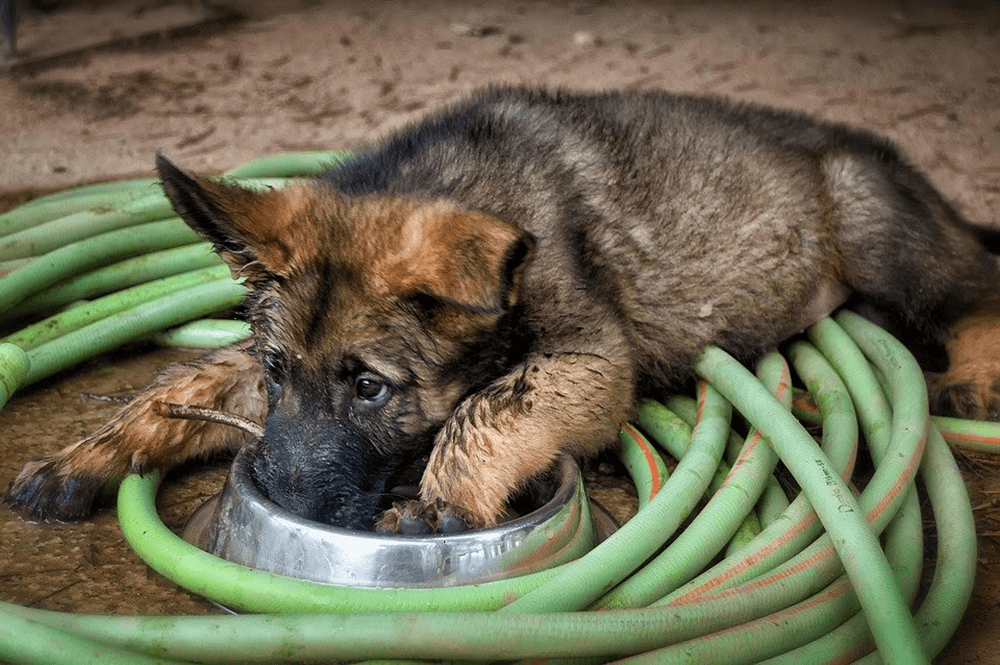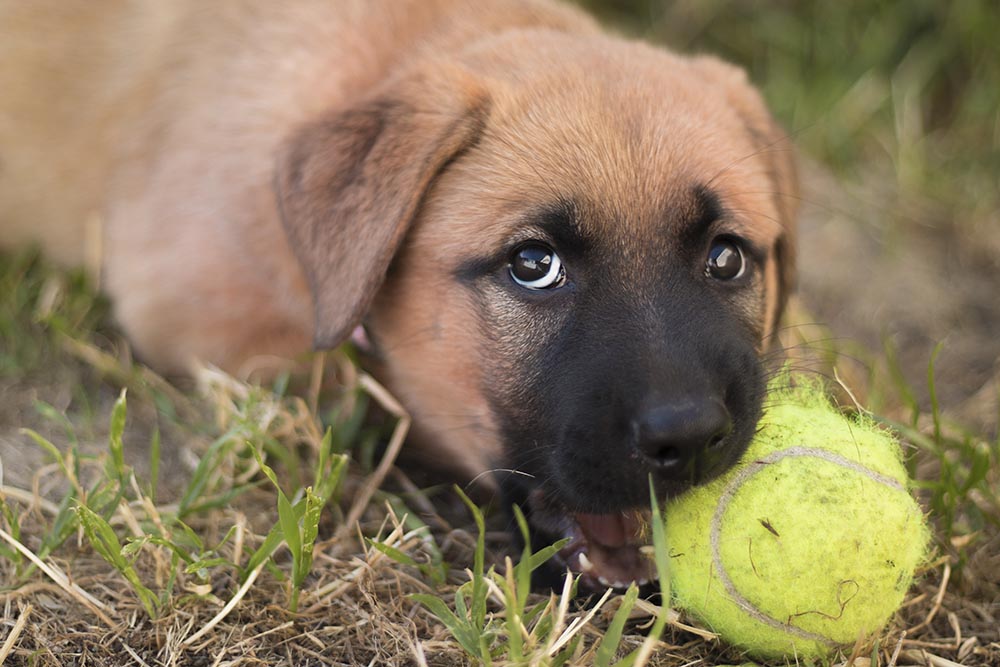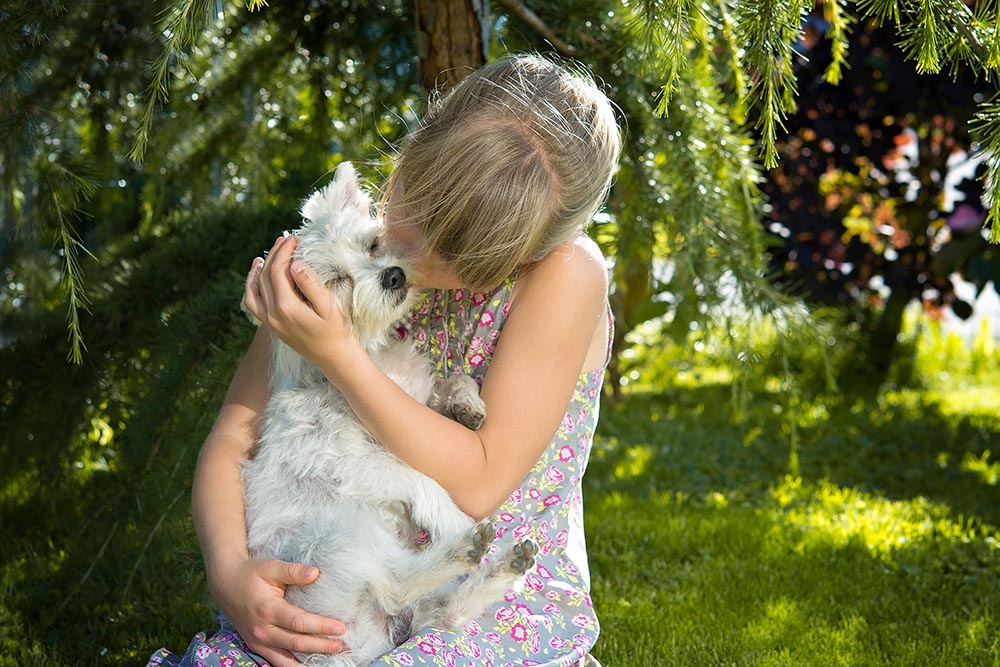Any organism with a complex brain can feel stress – the psychological strain caused by a situation perceived as dangerous or disturbing. And if you’ve lived with a dog, chances are you’ve observed one or two behaviors indicative of canine stress.
So, how can you tell when your dog is experiencing stress? And what can you do to make poor doggo feel better?
Read on as we discuss the common signs of stress in dogs and what pet parents can do to alleviate canine stress and anxiety.

Common stress signs in dogs
While animals can’t verbally communicate their feelings to us, your dog’s body language holds clues as to what they’re going through. Below, in no particular order, are the most common signs a dog is stressed.
1. Tail tucked between the legs
We dog owners often associate a tucked tail with fear in canines. However, whatever is making a dog feel nervous or scared is likely also giving them stress.
Alternatively, a dog may simply hang their tail straight down.
2. Revealing the whites of the eyes
A stressed-out dog may peel back their eyelids to reveal the crescent-shaped white portion of their eyes. It’s like they’re giving you the side-eye, only they’re not giving you any attitude but telling you they’re silently freaking out about something.
This is also called “whale eye” or “half-moon eye.”
3. Ears pulled back or perked up
When a dog is stressed, they may pull back their ears, pinning them flat against their skull. As a result, your doggy’s head seems rounder, which makes them look more adorable. But perhaps that’s the point. It’s almost like they’re saying, “Look at me, I’m no threat – there’s no reason to hurt me!”
In contrast, stressed dogs may stiffen and stick their ears straight up, instead. They may be focusing their hearing on the stressor in an attempt to determine whether or not it’s dangerous. Of course, this behavior is nigh unnoticeable in doggos whose ears remain floppy 24/7.
4. Lip licking
Lip licking isn’t always a sign of trouble – maybe your pet is just hungry!
However, anxious dogs lick their lips as a submissive or appeasing gesture meant to defuse what they perceive to be a potentially dangerous situation. If they smack their chops whenever a human or another animal enters the room, it’s likely the newcomer makes them nervous.
5. Displacement behaviors (excessive licking, scratching, etc.)
Displacement behavior is an activity – such as scratching, grooming, or yawning – that a doggy repeatedly engages in to comfort themselves when they’re feeling stressed.
For example, canines may repeatedly lick the floor, their bed, the furniture, or themselves. A stressed dog constantly licking one or more parts of their body may end up with self-induced sores a.k.a. acral lick dermatitis.
Because licking releases stress-relieving hormones known as endorphins in the body, a pooch that’s obsessively licking their paw is simply trying to soothe themselves after experiencing a stressful situation. It’s likely other displacement behaviors accomplish the same thing.
6. Prolonged, unexplained vocalization
Is your pet barking, whining, whimpering, growling, and/or panting excessively and for seemingly no reason? These may all be signs your dog is stressed.
Unfocused vocalization is especially common in dogs with separation anxiety.
7. Destructive chewing
Destructive chewing is common among unhappy doggies. They’ll rip up the furniture, your shoes, their toys, and more in an attempt to alleviate stress and express frustration.
Destructive chewing is another stress symptom common in dogs with separation anxiety.

8. Inability to relax (endless pacing, hypervigilance, tension)
Is your dog walking around the house or yard nonstop with no apparent purpose? Or are they repeatedly looking out the windows, checking the door, and patrolling the house like they’re on perpetual guard duty? Maybe they’re also barking at every noise and hint of movement?
A stressed or anxious dog won’t be able to relax. Even when they’re lying down, their body remains tense, and their eyes are wide open and alert.
9. Displays of aggression (lip curling, growling, etc.)
Nagging pet parents, excited children, and the like can unintentionally harass a pooch that’s already feeling anxious. When a dog’s stress levels peak, they may curl back their upper lip to reveal both teeth and gums – a warning that if the offending party doesn’t back off, they’ll have no choice but to fight.
Dog owners should respect this warning and leave the dog alone – it can be the difference between getting bitten and not getting bitten.
Other signs of aggression include growling, raised hackles, and snapping at you when you try to interact with them.
Such displays don’t always mean your doggo is upset, however. For instance, a growl can be playful. Raised hackles can mean excitement. To know which is which, you must pay close attention to your dog’s body language. If the growl is preceded by a lip curl and is accompanied by raised hackles and stiffened muscles, your dog is pissed off and ready to bite. If the growl occurs during a game of tug and is accompanied by a wagging tail, your doggy is just having fun.
10. Attention seeking
Is your dog being extra needy or clingy? Are they doing things to gain your attention such as jumping onto your lap, pressing their body against yours, staring and barking at you, or chewing something they’re not supposed to chew? A doggy that’s more attention-seeking than normal may be a dog stressed about something you’ve failed to notice.
11. Cowering posture
A stressed-out dog may move or sit with the shoulders raised high and the head bowed low, almost as if they’re trying to make themselves smaller.
12. Trembling
Many dogs that feel stressed can end up shaking all over as if from the bitter cold. While trembling may also be a sign your doggo is simply happy and excited, there’s a way to tell the difference between the two: if the tremors are accompanied by any of the other stress signs described in this article, then your dog is most likely not having a good time.

13. Freezing
Have you ever noticed a dog suddenly stop walking then turn into a statue? Freezing in place is an obvious sign of dog stress and anxiety. They’re so afraid even the slightest hint of motion will get them into trouble that they refuse to move a single muscle.
14. Hiding
If you’re an animal lover, you’ve probably observed one or two doggies slinking away to hide under the couch during a Fourth of July fireworks display. Squeezing themselves into a tight space where they can feel safe and secure is a common canine reaction to stressful situations such as an explosion of loud noises.
15. Social withdrawal
Is your dog actively avoiding all contact with you, your fellow humans, and your other pets? Sudden and extreme disinterest in social interaction is a major sign of dog stress as well as other serious health issues. Bring your poor pooch to a veterinarian for help.
16. Learned helplessness
Among the most depressing signs of canine stress is learned helplessness. In the most basic of terms, this is when a creature learns that there’s nothing they can do to stop an undesirable event from occurring, so they choose to do nothing about it. It’s essentially fatalism that develops in the canine after they’re repeatedly exposed to stressors they have no control over.
A dog with learned helplessness, for example, won’t attempt to flee if an abusive owner kicks them; they’ll just lie down and take the hit. Such a dog will show extreme passivity to stressors both old and new.
17. Lethargy
Because stress is draining, it can leave the sufferer feeling exhausted. So if your doggy shows little to no interest in walkies, games, and other forms of physical and mental stimulation, something may be bothering them.
18. Inconsistent sleep patterns
A dog that’s having a tough time falling asleep is exhibiting a common stress symptom. Excessive sleeping is another. Your pet may even switch between the two.
19. Changes in appetite
Stressful situations can result in a loss of appetite. Dogs may even start rejecting food.
On the other hand, a dog gobbling up their food with extreme haste may also be stressed. Canines with a history of being underfed by an abusive owner are more likely to behave this way because they fear their meal might be taken away from them any second.

20. Inappropriate urination or defecation
Is your dog unhappy with the loud noises outside the house? How about the strange people you’ve just brought home? Because of such stressors, poor Fido may be unable to help but pee or poop on the carpet, your bed, or anywhere else they’re not supposed to.
21. Gastrointestinal problems
Anxiety and stress in dogs can create chaos in your pooch’s digestive tract. The resulting gastrointestinal issues can then lead to vomiting, diarrhea, or constipation.
22. Drooling
Stress and anxiety in dogs sometimes manifest in excess saliva production, leading to drooling or frothing at the corners of their mouth. What a wet, slobbery mess stress can be!
23. Unexplained shedding
Shedding is normal for dogs; it’s their way of regulating their body temperature and getting rid of old hair. Doggos usually shed when the weather grows warmer, though when and how often your pooch sheds depends on their breed.
If Rover suddenly sheds for no reason, their mental health may be under attack by one or more stressors.
24. Rapid breathing
Is your dog’s chest expanding and contracting more rapidly than normal? An elevated heart rate, rapid and deeper breathing, and excessive panting are all signs your pooch is under a lot of stress. Of course, they could also mean your pet is suffering from a respiratory illness, heart disease, or any other medical condition, so don’t hesitate to bring your dog to the vet if these symptoms arise.
25. Sweaty paws
Canines sweat through their paw pads. Sweating is a normal function that keeps the body cool when the weather is hot or after rigorous physical activity that raises the body’s temperature. Like people, however, dogs also sweat whenever they feel stressed or anxious.
If Fido’s leaving sweaty footprints all over the floor even when the weather’s cool, it’s likely their stress level is going through the roof. Alternatively, it could mean they have a fever, so make sure to seek veterinary advice if you observe this issue.
26. Dilated pupils
Don’t be surprised, when you look into a stressed dog’s eyes, to see their pupils have dilated.
Pupil dilation is a natural, automatic response to fear-inducing stimuli and situations. The expanded pupils allow the eyes and consequently the brain to absorb more information about the environment, allowing the dog to make the best decision about their situation – whether that decision is to flee or to stay and fight.
Most dogs have brown or darker eyes, however, which makes pupil dilation generally hard to detect.

Common causes of canine stress
Knowing what’s causing your pet stress will help you determine how to make them feel better.
Here are the most common canine stressors:
1. Loud noises
Your dog may perceive sudden loud noises as a sign of imminent danger. Other types of noise, such as roaring music and screaming children, can become a source of irritation, especially to a doggy that’s trying to get some shut-eye.
2. General chaos
Like people, dogs enjoy their peace and quiet. Being stuck in an environment filled with children constantly running around won’t help your dog relax.
3. Space invaders
A dog likes having their own safe zone. A human or fellow pet constantly intruding on their private sanctuary can make your doggo feel unsafe and insecure. It’s much worse if they feel harassed by the intruder, such as when a child keeps pulling your dog’s ears while they’re trying to rest.
4. Separation
A dog might be convinced they’re being abandoned forever whenever their favorite human or fellow pet leaves the house.
Being pack animals, dogs may also be unable to tolerate isolation and are thus unable to remain calm when left home alone even for short periods.
5. Unexpected change
While most dogs enjoy novelty, others are unnerved by sudden, unexplained newness. Your doggo may end up stressed if you move the family into a new home, allow a stranger to touch them, take away their favorite toy, or even rearrange the furniture.
A change in family composition can make a dog feel uncertain about their position in the pack. Don’t be surprised to see shifts in your dog’s body language and behavior after you bring home a new family member such as a baby or an additional pet.
An abrupt change in routine (such as a sudden end to daily walks) can also make a dog upset.
6. Past trauma
Experiencing abuse, neglect, an accident, a natural disaster, or any other traumatic event can make a dog see potentially dangerous situations any time, anywhere. A history of severe trauma could even cause PTSD.
7. Boredom
A lack of mental stimulation and physical exercise can raise your dog’s stress levels.
8. Human stress
There’s scientific evidence humans can pass their heightened anxiety and stress levels into their furbabies. A house that’s home to constantly bickering humans will give a dog plenty of reasons to be grouchy.
9. Punishment
Shouting at or physically harming your dog can turn them into a nervous wreck. They may even continue to suffer the consequences of such abuse long after they’ve moved into a safe environment.
10. Conflict
If your dog doesn’t get along well with another pet or is unable to trust particular humans, they may learn to anticipate conflict in every encounter.
11. Inability to engage in normal behaviors
Not giving your dog any opportunities to be themselves can lead to a gamut of problems. If your dog’s breed was created for herding, for example, your dog will have an inherent desire to herd. Such a dog will benefit from any activity similar to herding or that, at the very least, allows them to release their pent-up energy.
12. Confusion
Old age affects every dog’s brain. In some cases, it can lead to stress-inducing confusion and/or memory loss.

Reducing your dog’s stress or anxiety levels
Here are some helpful tips on how to reduce your dog’s stress or anxiety.
1. Professional assistance
One of the first things you should do when you see signs of stress in your dog is to seek a veterinarian’s help.
A vet will determine if there are any underlying medical conditions behind your dog’s distress. Based on their findings, they’ll provide treatment that’ll not only correct the health issue but also alleviate its adverse effects on your dog’s mental health. Your vet can also prescribe medication specifically designed to relieve stress and anxiety.
Many dogs that experience intense psychological discomfort can also benefit from being examined by an animal behaviorist. This professional can identify your dog’s issues, then teach you strategies that can help your dog get better.
2. Physical and mental stimulation
Regular physical activity will prevent boredom and grant your dog an outlet for pent-up energy and frustration. So walk your dog daily, play games with them, and let them run around your yard.
Walks also introduce dogs to new, mind-nourishing experiences. Ensure you give Fido ample opportunities to stop and take in all those fascinating scents, sights, and sounds.
Go on hiking, camping, and swimming adventures, as well as trips to pet-friendly locations that’ll allow them to interact with other dogs and people.
Toys designed to exercise the doggy brain can also ward off anxiety and stress.
3. Training
Training cultivates the human-canine bond. The stronger this bond, the more your dog trusts you, which helps eliminate feelings of insecurity your presence previously triggered. Additionally, it removes any uncertainties that can give rise to stress.
There are also specific training techniques that can treat canine stress and anxiety.
Desensitization entails gradually introducing your dog to a stressor until they get used to it. For instance, if your dog is afraid of the new cat, you can cut their first encounter off after a minute. On the second day, increase the encounter duration to two minutes, the third day three minutes, and so on. Repeated exposure to a stressor instills confidence in your pooch until they’re no longer bothered by it.
Counterconditioning alters your pet’s response to the stressor. This simply means rewarding your pet every time they’re exposed to the stressor so that they learn to associate it with something desirable. So if you give your dog a treat every time they meet the cat, they’ll eventually enjoy spending time with the cat.
Counterconditioning and desensitization go hand in hand. If you wish, you can seek the assistance of a professional trainer.
4. Crate training
Crate training, especially if done early, is an effective way to combat canine separation anxiety. As long as you use proper technique, your pooch will eventually learn to be comfortable being alone for a long period of time.
5. Safe space
You can give your pooch a space they can call their own, whether it’s in the yard or inside the house. You can install a safety gate to ensure no children or other animals can enter this area.
A crate or dog house can also serve as the safe zone your doggy can retreat into when they need to take time out from the world.
6. Love and affection
As it’s important to make your dog feel safe around you, always shower them with love and affection. Regular cuddle sessions, positive reinforcement via treats and praises, and generally being calm, happy, and playful around your furry friend will strengthen the human-canine bond and do wonders for your pet’s mental well-being.
7. Spa treatment
Help your pet pal relax – give them a soothing spa treatment at home by massaging their aching muscles or brushing their hair! However, you should observe their body language to determine if they’re receptive to the treatment. If your dog closes their eyes and sighs contentedly, you’re on the right track. If they tense up, stare at you, or show their teeth, it’s best to leave them alone.
Aromatherapy can also help your doggo. A 2018 study involving shelter dogs found that “exposure to ginger, coconut, vanilla, and valerian resulted in significantly lower levels of vocalizations and movement compared to the control conditions, while coconut and ginger additionally increased levels of sleeping behavior.”
8. Prevention
You can reduce or eliminate the sources of your dog’s anxiety and stress.
If sudden changes get on their nerves, aim for consistency in routine and experiences. For example, try as much as possible not to miss any walks. If you have to hire a dog walker, hire the same person every time.
If loud noises freak out your doggo, don’t blast any grating music on the stereo.
If there are children in the house, instill in them the value of loving and respecting all animals. And teach them not to bother a dog that’s in serious need of some alone time!

Conclusion
Paying attention to your dog’s behavior can go a long way in ensuring they enjoy a happy, healthy, stress-free life. So familiarize yourself with all the symptoms of canine stress – both you and your dog will benefit from it!
